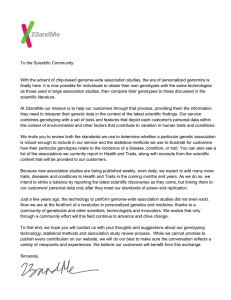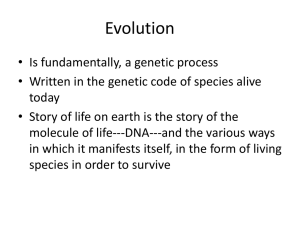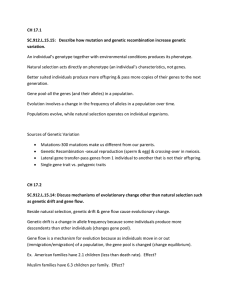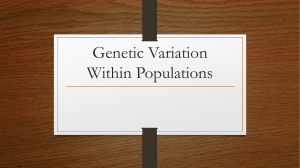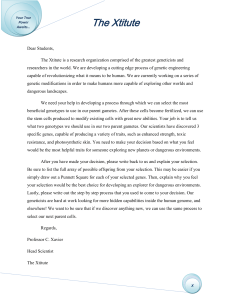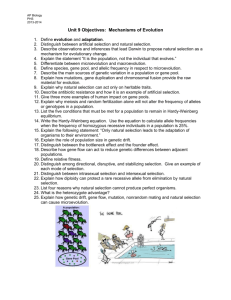What is Evolution?
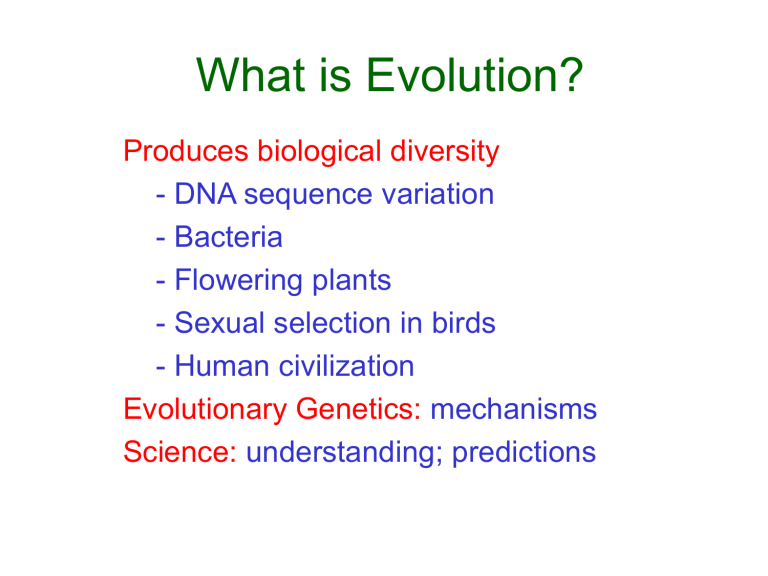
What is Evolution?
Produces biological diversity
- DNA sequence variation
- Bacteria
- Flowering plants
- Sexual selection in birds
- Human civilization
Evolutionary Genetics: mechanisms
Science: understanding; predictions
Evolution: definition
Darwin: "descent with modification“
A change in morphology, ecology, behaviour, physiology
Change must be genetic
Modern, genetic definition:
“evolution is change in gene frequencies between generations”
What causes evolution?
a) Natural selection b) Mutation c) Genetic drift, or neutral, random evolution e) Migration, or gene flow
This lecture: simple examples of evolution by natural selection
What is natural selection?
“a consistent bias in survival or fertility between genotypes within generations”
Selection often causes evolution , but may also prevent evolution (e.g. stable polymorphism)
Evolution does not require selection (e.g. drift -important: > 95% of genome maybe "junk"!)
However, many interesting types of evolution involve natural selection
Evolution, a fact?
You don’t have to believe in evolution to take this course, but you do have to know the arguments to get a good grade!
Evolution is a fact , and it’s hard to ignore
… but, theory and fact: not so different
Science: prediction
According to Karl Popper: science is falsifiable.
Falsehoods disprovable; truth more difficult!
Religion: truth is by faith. Very different.
Selection and the single gene
“Quantitative traits” (e.g. size, behaviour): usually multiple loci
Single-locus traits: great examples of evolution by natural selection
Many single-locus traits are involved in resistance to stress (often humans )
Examples of single-gene traits
• Industrial melanism in moths (resistance to urban pollution)
• Heavy metal tolerance in plants growing in mine tailings
• Malaria resistance in humans (sickle-cell haemoglobin, etc.)
• Pesticide resistance (mosquitoes, insects, weeds, fungi, warfarin resistance in rats)
• Antibiotic resistance in bacteria
We used to do this for tutorial; there are many references on reserve, still; see eUCLid
The peppered moth Biston betularia
Left: form typica (left, and carbonaria (right) on lichen-covered trunk in Dorset.
Right: on soot-covered tree near Birmingham
How does evolution by natural selection work?
Evolution by natural selection is an inevitable, mathematical process .
The frequency of a particular allele will change, and its rate of change will depend mathematically on the advantage (or relative fitness) of that allele.
Mathematical evolutionary theory is useful . For example, given information about natural selection, how rapidly will evolution occur?
The answers help us understand antibiotic resistance, or pest resistance, for instance.
Evolution is a predictive science!
Useful, as well as fun!
A flow diagram for
Random mating
Offspring genotypes in
Hardy-Weinberg ratios
Natural selection
Offspring after selection
So now you can write an evolution computer program!
Numerical vs. analytical theory
Take-home points
Evolution to a geneticist: a change in gene frequencies.
Natural selection: a consistent bias favouring some genotypes over others.
Evolution can occur in the absence of natural selection , via genetic drift or neutral evolution.
Natural selection can stabilize the status quo; zero evolution .
Evolution at a single dominant gene: rate can be predicted
If selected, dominant alleles evolve quickly when rare , slowly when common; recessive alleles evolve slowly when rare , quickly when common.
We can estimate selection coefficients ( s ), fitnesses ( W =1 -s ) and predict rates of evolution from data on survival or fecundity.
Mathematical theory makes evolution a predictive science
Further reading
FUTUYMA, DJ 1998. Evolutionary Biology. Chapters 12 and 13
(pp. 371-381).
References on natural selection at single genes for resistance (see web)
Science Lbrary: View B242 Teaching Collection by going to eUCLid ; use
Keyword, Basic Search, All Fields: B242
